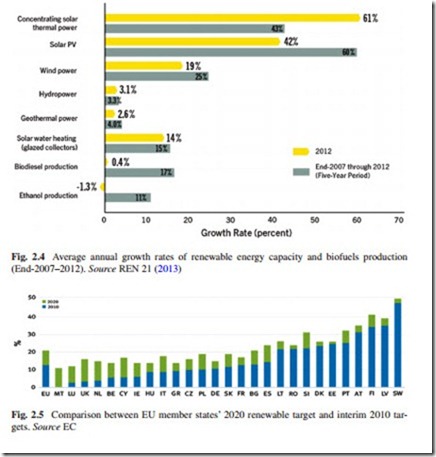Share of Renewable Energy Sources in Gross Domestic Energy Consumption
Global demand for renewable energy continued to rise during 2011 and 2012, despite the international economic crisis, ongoing trade disputes, and policy uncertainty and declining support in some key markets. Renewable energy supplied an estimated 19 % of global final energy consumption by the end of 2011, the latest year for which data are available. Of this total, approximately 9.3 % came from traditional biomass, which is used primarily for cooking and heating in rural areas of developing countries. Useful heat energy from modern renewable sources accounted for an estimated 4.1 % of total final energy use; hydropower made up about 3.7 %, and an estimated 1.9 % was provided by power from wind, solar, geo- thermal, biomass, and by biofuels. Renewables are a vital part of the global energy mix and should play a major role during the coming decades. Modern renewable energy can substitute for fossil and nuclear fuels in four distinct markets: power generation, heating and cooling, transport fuels, and rural/off-grid energy services. However, this could happen in a number of countries, but not in others.
During the five-year period 2008–2012, installed capacity of many renewable energy technologies grew very rapidly, with the fastest growth in the power sector with the purpose of reducing the use of oil and coal, and in some specific cases nuclear energy. Total capacity of solar PV grew at rates averaging 60 % annually. Concentrating solar thermal power capacity increased more than 40 % per year on average, growing from a small base, and wind power increased 25 % annually over this period. Hydropower and geothermal power are more mature technologies and their growth rates have been more modest, in the range between 3 and 4 % per year as average. Biopower is also mature, but with steady growth in solid and gaseous biomass capacity, increasing at an average 8 % annually (REN 21 2013).
According to Fig. 2.4, the participation of CSP in the generation of electricity increased 18 % during the period 2007–2012.
For 2020, it is expected that the share of renewable energies in gross domestic energy consumption in the EU be not less than 20 %, and a binding 10 % target for the share of renewable energy in transport petrol and diesel, instead of a target of 5.5 % pre- viously approved. This implies that the EU power sector continues its move away from the use of fuel oil, coal, and in some countries, nuclear power for electricity generation, whilst at the same time increasing its total installed capacity to meet increasing power demand. The net growth in the last eleven years of natural gas power (118.2 GW), wind power (74.3 GW) and solar PV (26.4 GW) was at the expense of fuel oil (down 13.2 GW), coal (down 9.5 GW) and nuclear energy (down 7.6 GW).
Figure 2.5 shows the evolution of the renewables target for all EU countries from 2010 and 2020, the country with the best situation to reach the EU target is Estonia, followed by Sweden, Romania and Denmark.
